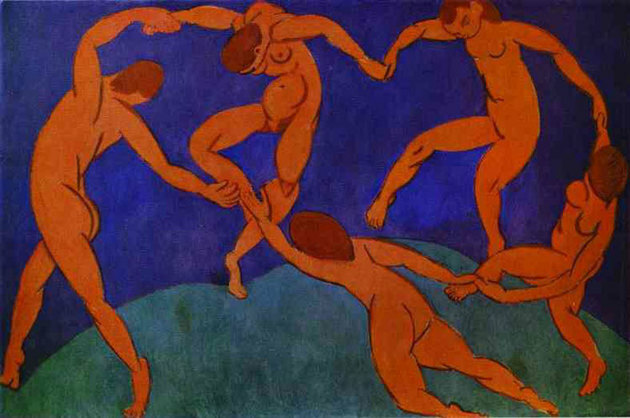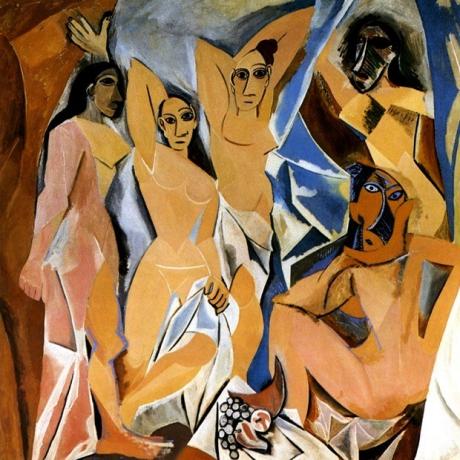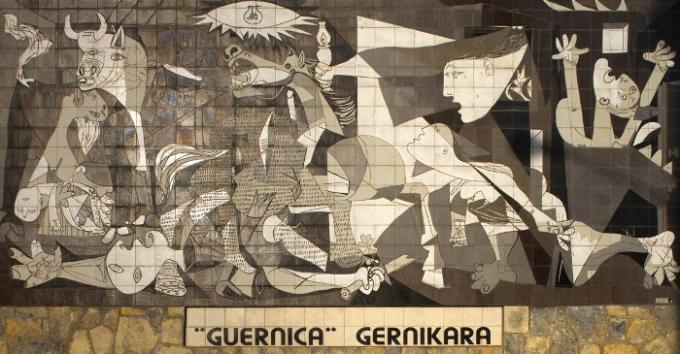At European vanguards they represent a set of artistic-cultural movements that took place in different parts of Europe from the beginning of the 20th century.
The European artistic vanguards that stood out were: Expressionism, Fauvism, Cubism, Futurism, Dadaism, Surrealism.
Together, these movements have influenced modern art worldwide from painting, sculpture, architecture, literature, cinema, theater to music, etc.
The artistic avant-gardes surpassed the limit found in the arts until then, proposing new forms of aesthetic performance by questioning the imposed standards.
In Brazil, they directly influenced the modernist movement, which began with the Week of Modern Art in 1922.
The word vanguard, from the French “avant-garde” means the “advanced guard”, which presupposes, in this context, a pioneering movement of the arts.
Historical Context of European Vanguards
With the advent of the Industrial Revolution in the 19th century and the First World War in the beginning of the 20th century, society was going through several transformations.
Technological advances, industrial progress, scientific discoveries, among others, stand out.
In this sense, art demonstrated the need to propose new aesthetic and artistic fruition forms, based on current reality.
In this way, the European artistic movements that emerged in the fervor of the ideals of the time were directly against the ideals of war.
Artists used irony and the ability to “shock” the public in order to awaken other ways of appreciating and reflecting on life.
On the other hand, one of them extolled technological advances and progress, in this case Italian futurism.
Learn about the historical context: First World War
European Artistic Vanguards: Summary
Check below each of the European artistic vanguards, their main characteristics, artists and works:
Expressionism

Appeared in Dresden, Germany, in 1905, the expressionism was an artistic movement that originated with the group Die Brucke - which in Portuguese means "The bridge".
Ernst Kirchner, Erich Heckel and Karl Schidt-Rottluff were the artists who came together to create this collective based on the expression of feelings and emotions.
It had a truly subjective, irrational, pessimistic and tragic character, precisely because it emphasized the ailments and problems of human beings.
This art style comes as an opposition to another earlier movement, the impressionism.
the Norwegian artist Edward Munch can be considered the great inspiration of the Die Brucke and forerunner of expressionism. His most important work is The Scream (1893), one of the most emblematic of the painter.
In addition to him, the artist deserves to be highlighted. van gogh, which also profoundly influenced the movement.
Fauvism

Fauvism was a style of painting based on chromatic intensity, simplification of forms and the use of pure colors, in addition to using them arbitrarily, without compromise with real colors.
Because of these characteristics, during the Autumn Salon, some painters of this movement were called by critics as fauves ("the beasts" in Portuguese), as a rejection of the new way of painting.
Some important names in Fauvism are: André Derain, Maurice de Vlaminck, Othon Friesz and Henri Matisse, the most known.
Read more about the Fauvism.
Cubism

O cubism it was an artistic movement based on the geometrization of forms.
It was started in 1907 by the Spanish painter Pablo Picasso, with the screen "Les Demoiselles d'Avignon"(The Ladies d'Avignon).
Other representatives of the movement were: Georges Braque, Juan Gris and Fernand Léger.
This artistic current was inspired by the work of the artist Cézanne and branched out into two strands: analytical cubism and synthetic cubism.
In the first, the analytic, the shapes and figures were so deconstructed and fragmented that they became unrecognizable. In synthetic cubism, artists returned to figurative representation, but not to a realistic approach to themes.
In Brazil, the Cubist movement influenced some artists, such as Tarsila do Amaral and Vicente do Rego Monteiro.
futurism

O futuristic movement it was headed by the Italian poet Filippo Marinetti, who released a manifesto published in a French newspaper (Le Figaro) on February 20, 1909. The following year, several artists launched a Futurist Manifesto directly related to painting.
Its main characteristics were the exaltation of technology, machines, speed and progress. One of the exponents of futuristic painting was the Italian artist Giacomo Balla. Other representatives are: Umberto Boccioni, Carlo Carrà, Luigi Russolo and Gino Severini.
In Brazil, the ideals of Modern Art Week, which inaugurated the modernist movement in the country, were influenced by futurism. This is because the rejection of the past, as well as the cult of the future, propelled modernist ideas.
Dadaism

O Dadaism it was an illogical movement spearheaded by Tristan Tzara in 1916, who later became known as the propellant of surrealist ideals.
Besides him, other leaders of the movement were: the German poet Hugo Ball and the Franco-German painter, sculptor and poet Hans Arp.
The main characteristics of Dadaism are the spontaneity of art based on freedom of expression, absurdity and irrationality.
Without a doubt, the French painter and sculptor Marcel Duchamp he was one of the most emblematic figures of the Dada movement with his finished objects (ready-made) that deviate from their original function. THE Source is one of the most representative works of that moment.
Surrealism

O surrealism, led by artist André Breton, emerged in Paris in 1924.
Based on the subconscious, this movement was characterized by an impulsive, fantastic and dreamlike art.
Some artists that deserve mention are Giorgio de Chirico, Max Ernst, Joan Miró, René Magritte and Salvador Dalí.
Brazilian literature and plastic arts were greatly influenced by this vanguard. Noteworthy: writer Oswald de Andrade and plastic artists Tarsila do Amaral, Ismael Nery and Cícero Dias.
European Vanguards - Entrance Exam Questions
1. (UFPE-PE) The cultural movements of the late nineteenth century and the first decades of the twentieth century dialogued with the changes that occurred in society, with the affirmation of the capitalist mode of production and with new ways of thinking and feeling the world. With modernism and artistic avant-gardes, there were important changes, as
The. ( ) Dadaism sought to radicalize its proposals, criticizing established values, with emphasis on the work of artists such as Marcel Duchamp.
B. ( ) Surrealism brought the exploration of the unconscious, present in the painting of the Spaniard Salvador Dali and in the literary work of the Frenchman André Breton.
ç. ( ) with works that made an impact, there was a break with the classical models that adopted rules and limits for the artist.
d. ( ) Cubism was the movement that most explored subjectivism, showing an intense concern with human suffering.
a) V - V - V - V
b) V - V - V - F
c) V - V - F - F
d) V – F – V – F
Alternative b: V – V – V – F
Dadaism was a movement characterized by "anti-art" and the questioning of what art would be in the face of the absurdities that occurred in the world with the First War. Duchamp, inventor of the so-called ready-mades, was one of the greatest exponents of this movement.
Surrealism was concerned with the exploration of unusual themes, the oneiric universe (of dreams), creating relationships even with psychoanalysis, which was also emerging at the time.
The avant-gardes were movements that sought to break with the characteristics of current art, proposing new ways of making and enjoying art.
Cubism did not explore the subjective and its main interest was not human suffering. It was a trend that brought new forms of representation in the pictorial field, defragmenting and geometrizing the figures.
Also check out this selection of questions that we have separated for you to test your knowledge: Exercises on European Vanguards.
2. (ESPM-SP) Check the text:
“We edged in car by the tree-lined rental mirror of the sunless sea boulevards.
Tenuous diamonds of gold flag nationalized the green of the inner hills.”
This fragment of the work Sentimental Memories of João Miramar, by Oswald de Andrade, reveals the influence of a European avant-garde current of Modernism. Mark it:
a) Futurism, due to the exaltation of speed and automotive technology.
b) Surrealism, as the unusual images presented seem to have been extracted from the narrator's dream or unconscious.
c) Cubism, since only parts of the objects and the landscape are described, the image is fragmentary.
d) Expressionism, through caricaturization, through the deformation of the image through exaggeration.
e) Dadaism, as the meaning of the text is none, since the ideas are randomly mixed.
Alternative e: Dadaism, as the meaning of the text is none, as the ideas are randomly mixed.
In the Dada movement, the intention of the artists was to produce a type of art "meaningless", an "anti-art", questioning the standards and concepts that lead to declaring what art is or is not. When analyzing Oswald de Andrade's text, we can see a play on words that do not produce an explicit meaning, which links it to Dadaism.
3. (UCP-PR) Brazilian literary movement that received influences from European vanguards, such as Futurism and Surrealism:
a) Modernism
b) Parnassianism
c) Romanticism
d) Realism
e) Symbolism
Alternative to: modernism
Brazilian modernism was an artistic current that sought to "drink from the fountain" of the European avant-gardes, but intensely bringing the elements of national culture, thus producing an art that is genuinely Brazilian.



